Help us protect the commons. Make a tax deductible gift to fund our work. Donate today!
We’re excited to share this post from Mikka Gee Conway and Uma Nair of the Getty, which describes the history and curation of the remarkable new online exhibit, The Legacy of Ancient Palmyra. The Getty’s exhibit, the first of its kind, is part of ongoing global efforts to call attention to the continued destruction of one of the world’s most important heritage sites due to the ongoing Syrian conflict.
In April, Creative Commons unveiled a collaboration with #NEWPALMYRA and re:3D at the CC Summit, a large scale rendering of one of the destroyed Palmyra tetrapyla.
On February 8, 2017, the Getty Research Institute (GRI) in Los Angeles unveiled its first online-only exhibition, The Legacy of Ancient Palmyra. Featuring over one hundred images primarily drawn from the Special Collections of the GRI, the exhibition explores Palmyra’s early history, its influence on Western art and culture, and the tragic loss of what is left of its ancient ruins amid the devastating ongoing war in Syria. Most of the images, and all of the texts, included in the online presentation are licensed under the Creative Commons Attribution 4.0 International Public License (CC BY).

Temple of Baalshamin, Louis Vignes, 1864. Albumen print. 8.8 x 11.4 in. (22.5 x 29 cm). The Getty Research Institute, 2015.R.15
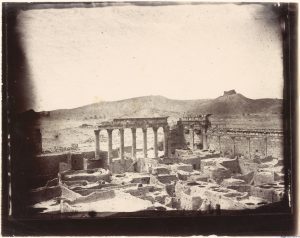
Temple of Bel, Louis Vignes, 1864. Albumen print. 8.8 x 11.4 in. (22.5 x 29 cm). The Getty Research Institute, 2015.R.15
The core of the exhibition comes from two bodies of work in the GRI’s Special Collections by 18th- and 19th-century Frenchmen who visited Palmyra: etchings by artist and architect Louis-François Cassas, made in 1785 as part of a diplomatic mission to the Ottoman Empire; and photographs made in 1864 by sea
captain-turned-photographer Louis Vignes as part of a scientific expedition to the Middle East. These collections include the first photographs of the ancient monuments of Palmyra, illustrating the Temple of Baalshamin, the Temple of Bel, the Monumental Arch, and the Tetrapylon, destroyed in 2015 and 2017 by ISIS.
Curators Frances Terpak and Peter Bonfitto, along with the rest of the exhibition team, wanted not only to give viewers a broader historical perspective on Palmyra, a city with a particularly rich and poignant history, but also to create a free visual resource enabling anyone with an internet connection to have digital access to these rare, unpublished materials and accompanying scholarly discussion.
With a goal of offering the same depth and breadth of material as an on-site gallery exhibition, The Legacy of Ancient Palmyra contains 108 images, including 20 “loan objects” from other institutions, and more than 18,000 words of peer-reviewed scholarly text. The majority of the images can be downloaded and feature a “zoom” tool. Created as an informative experience for the general public and a research tool for scholars, The Legacy of Ancient Palmyra includes a resource page which provides links and further readings on both the history of the site and current events.
In building this exhibition, some of the questions we asked ourselves were: how do we take a visitor’s gallery experience–such as looking closely at an object and then standing back in the middle of the room for a different perspective–and translate this to desktop, tablet, and mobile devices? How do we translate an ancient city plan into an interactive and user-friendly digital platform? To answer these questions, our core working group, each bringing different areas of expertise, brainstormed ideas, did rapid sketching exercises, and tested with our three core audiences: (1) an international scholarly audience; (2) “enthusiasts,” whom we defined as the culturally curious but not subject-matter experts; and (3) teachers and students seeking credible sources of information on the region and on ancient history, political science, cultural heritage, and the arts generally
On the design side, our visual designers worked very closely with the curators to gain a very deep understanding of the intellectual component of the material and what the curators wanted to convey. They also used the original material as inspiration to visually present a connection between the 18th and 19th century materials and bring them into our 21st-century digital environment.
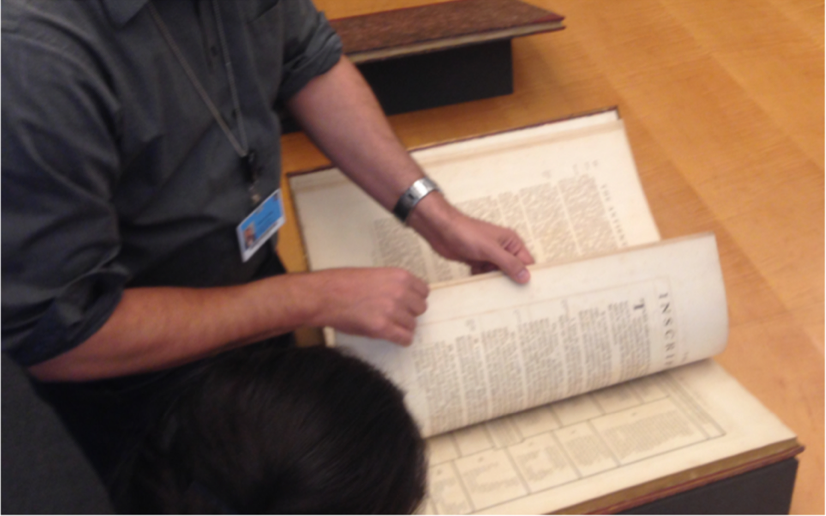
Curators and the visual designers leaf through pages of The ruins of Palmyra, otherwise Tedmor, in the desart (London, 1753) by Robert Wood at the Getty Research Institute’s Special Collections and Reading Room.
Through a Visual Design Workshop, our team and stakeholders developed a common language and a set of visual cues for what we wanted the user experience to be like.
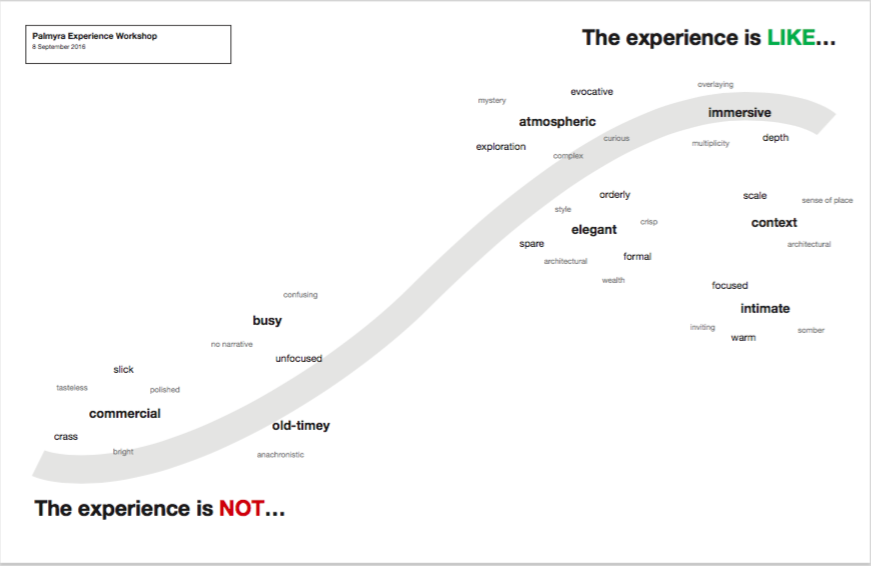
Snapshot of keywords from the Palmyra Visual Experience Workshop revealed that the team wanted the online experience to be elegant and immersive and not feel commercial or old-
timey.
On the rights side, we knew from the outset that we wanted to publish The Legacy of Ancient Palmyra as openly as possible. The J. Paul Getty Trust, of which the GRI is part, was established for “the diffusion of artistic and general knowledge.” The Getty has long been committed to creating and disseminating knowledge in the fields in which it works. More recently we have embraced open access principles, and are committed to providing, wherever possible, free, unrestricted, digital access to the resources we own and produce. For example, our Open Content Initiative launched in 2013 and offers free, unrestricted, high-resolution images from the collections of the GRI and the J. Paul Getty Museum—at last count, 114,000 images and growing. We publish textual information on the Getty Museum’s online collections pages and the Getty’s blog under CC BY, as we did with two new online catalogues on the Getty Museum’s collections of Roman mosaics and ancient terracottas. Both the GRI and the Getty Conservation Institute (GCI) have developed open-source software projects to serve their audiences, including Getty Scholar’s Workspace®, the GRI’s collaborative research tool, and the GCI’s Arches™ software platform, a geospatially-based information system for inventorying immovable cultural heritage. Research resources maintained by the GRI are also available under open licenses, including datasets from the Getty Provenance Index® and the Getty Vocabularies, many of which are available as Linked Open Data under Open Data Commons licenses. In addition, the Getty Foundation has just published Museum Catalogues in the Digital Age, the final report on its Online Scholarly Catalogue Initiative, under CC BY.
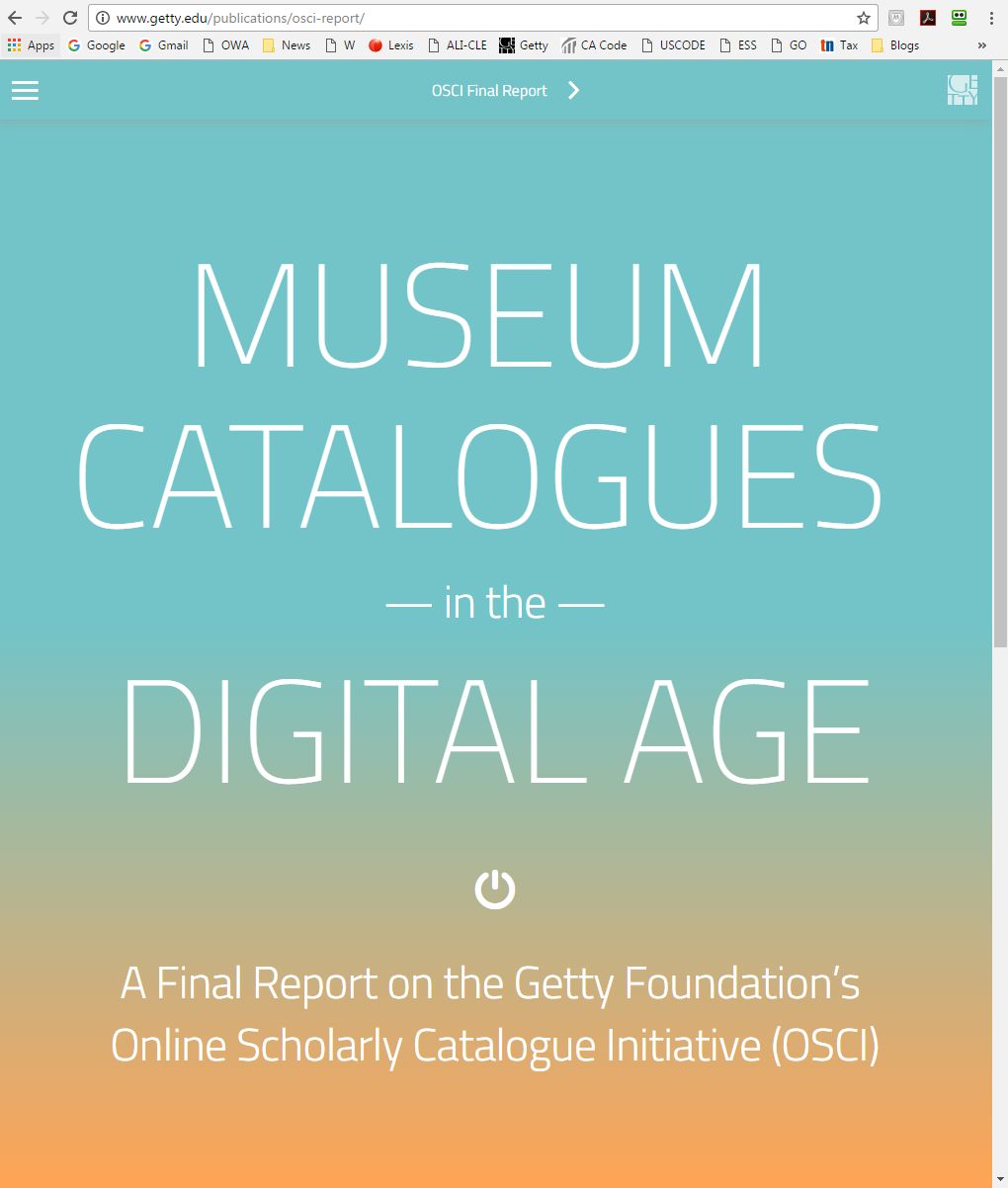
Museum Catalogues in the Digital Age: A Final Report on the Getty Foundation’s Online
Scholarly Catalogue Initiative (OSCI) is licensed, with a few exceptions, under CC-BY.
Given the nature of the vast majority of the source material for Palmyra—public domain artwork owned by the GRI and texts written by GRI staff—we knew it would be possible to apply a CC BY license to most if not all of it. Unfortunately we were not able to secure permissions from the “lenders” to apply CC BY to their objects, with the exception of the National Gallery of Art in Washington, which like the Getty makes its public domain collections images freely available. But with a clearly written image credits section and targeted use of the Creative Commons machine-readable code, we were able to identify for human and machine readers which parts of the exhibition are not part of the open license.
The exhibition has received much positive coverage and feedback from around the world, including from a teacher who planned to use the exhibition in the classroom for a lesson on Palmyra. We’re pleased to have created another cultural and educational resource that is freely available to all who can access it – please come visit the site and let us know what you think. We hope there will be robust re-use and repurposing of this content, and we will continue to look for ways that the Getty can add to the world’s cultural commons.
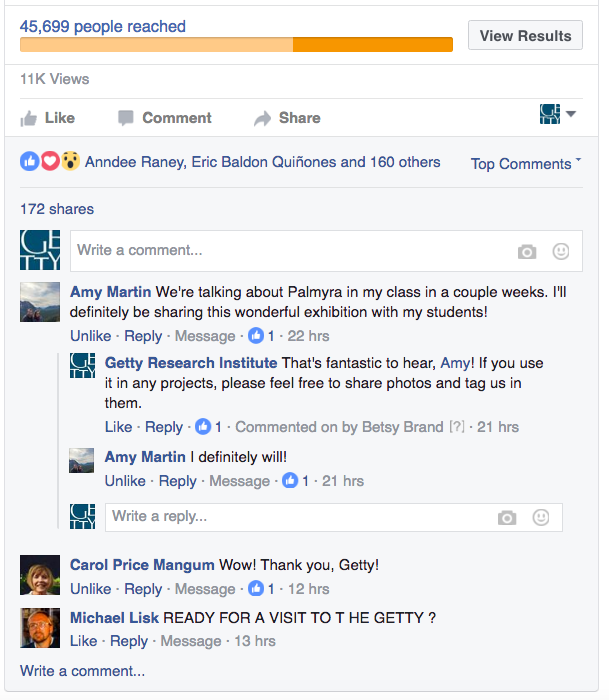
A snapshot of one of the many responses received on social media about the relevance of the online exhibition in today’s world.
Posted 31 May 2017